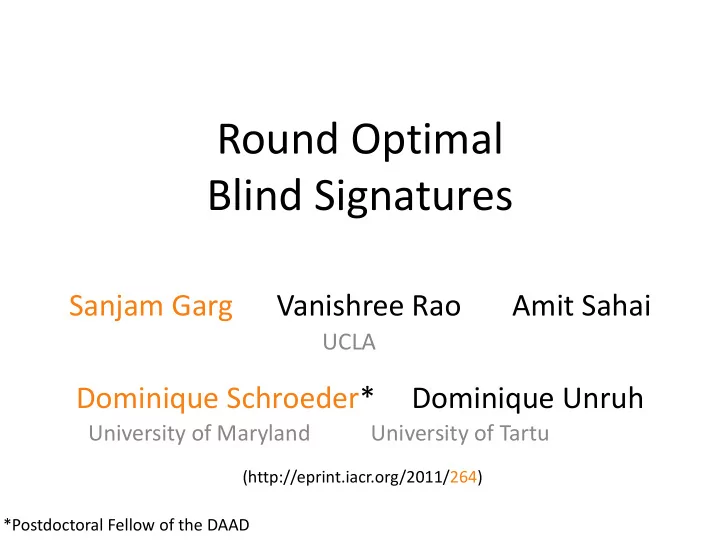

Round Optimal Blind Signatures Sanjam Garg Vanishree Rao Amit Sahai UCLA Dominique Schroeder* Dominique Unruh University of Maryland University of Tartu (http://eprint.iacr.org/2011/264) *Postdoctoral Fellow of the DAAD
Blind signatures [C85] signer user • Signer does not “see” the message m • User cannot produce more signatures then # interactions CRYPTO 2011 Dominique Schröder 2
Blind signatures [C85] signer user • Signer does not “see” the message m • User cannot produce more signatures then # interactions CRYPTO 2011 Dominique Schröder 3
Applications • eCash • eVoting – User cannot vote for an additional candidate (unforgeability), voting agency does not see the vote (blindness) – FIFA world soccer cup selected in 2002 Most Valuable Player using Votopia • Anonymous credentials – Microsoft U-PROVE – National Strategy for Trusted Identities in Cyberspace - NISTIC CRYPTO 2011 Dominique Schröder 4
W hat’s next? • Security model • Our contribution • Related work • Construction • Relation to FS [10] CRYPTO 2011 Dominique Schröder 5
Security model Unforgeability [JLO97,PS00] n-times signer user CRYPTO 2011 Dominique Schröder 6
Security model Blindness [JLO97,PS00] user user (Aborts: PKC, FS[09]) CRYPTO 2011 Dominique Schröder 7
Simple question: signer user Two moves? CRYPTO 2011 Dominique Schröder 8
Known constructions over 80 papers published 2 moves (optimal): Chaum, Boldyreva: interactive assumption, ROM Fischlin: CRS 3 moves: Pointcheval Stern, Abe ROM 4 moves: Okamoto TCC06 CRYPTO 2011 Dominique Schröder 9
Simple question: Reduce the round complexity of a known scheme. Prove the security of a known two move scheme in the signer user standard model. Construct a completely new scheme. CRYPTO 2011 Dominique Schröder 10
Simple question: Prove the security of a known two move scheme in the standard model. Fischlin, S[FS10]: No security reduction for one of the known two/three moves schemes to any non-interactive problem in the standard model. Extension: Pass (STOC 11): unique blind signature. CRYPTO 2011 Dominique Schröder 11
Simple question: signer user Two moves? (Caution: actual results may vary) CRYPTO 2011 Dominique Schröder 12
First stab • Idea: Use Yao’s garbled circuit with OT • Yao allows private evaluation of any general circuit – Consider the signature evaluation circuit • We also need a 2 round OT protocol [NP01, AIR01] – This protocol is not simulatable – Computational security for sender and statistical security for receiver CRYPTO 2011 Sanjam Garg 13
First stab • Idea: Use Yao’s garbled circuit with a 2 round Need to make it fully secure. OT protocol [NP01, AIR01] OT 1 OT 2 ,Yao signer user Problem: 1) Yao is only semi-honest secure and 2) OT is not simulatable CRYPTO 2011 Sanjam Garg 14
Cheating signer Unique signature OT 1 OT 2 ,Yao In fact PRF suffices signer user • What can a cheating signer do to break blindness? – Encode any arbitrary function inside the Yao’s garbled circuit. More fundamental issue – Manipulate the randomness used in signing to break blindness CRYPTO 2011 Sanjam Garg 15
Enforcing correct behavior OT 1 OT 2 ,Yao signer user • Signer additionally needs to prove correctness of its actions. • Idea: Use a proof protocol – What proof protocol can be used? – Standard ZK requires 3 rounds CRYPTO 2011 Sanjam Garg 16
Super-Poly Simulation based ZK [ Pass03 ] x in L Accepts/Rejects zk 1 zk 2 Prover Verifier • Zero Knowledge – For every cheating verifier V there exists a simulator S running in super poly time that can simulate the view of the verifier CRYPTO 2011 Sanjam Garg 17
Protocol so far OT 1 ,zk 1 OT 2 ,Yao, zk 2 signer user • We have limited the signer in cheating by – Using deterministic signatures – Enforcing honest behavior by a Zero Knowledge protocol • Have we solved the problem of cheating signer? – Subtle issue remains: in proof of security, need to extract signatures – Solution: Use super-poly-time extraction – But can avoid the use of super-poly-time by specific rewinding technique (see paper) CRYPTO 2011 Sanjam Garg 18
Cheating user – arguing unforgeability • Simulator simulating the view of the verifier is super-polynomial • Deal with this by using signature scheme that is unforgeable even by an adversary secure against super-poly time adversaries. (complexity leveraging) • This allows us to argue unforgeability. CRYPTO 2011 Sanjam Garg 19
Relation to FS[10] • FS[10] proved impossibility of three round blind signature schemes • Restricted to blind signature schemes with some technical properties • Blindness holds with respect to a forgery oracle as well • Our scheme avoids this, but still achieves full security. CRYPTO 2011 Sanjam Garg 20
Open Problems • Improvements in terms of assumptions • We require sub-exponentially hard OWFs, trapdoor permutations and DDH (Impossible from OWP: Katz, S, Yerukhimovich, TCC 2011) • Efficient constructions CRYPTO 2011 Sanjam Garg 21
Thanks Vanishree Rao Amit Sahai Dominique Unruh CRYPTO 2011 Sanjam Garg and Dominique Schröder 22
More recommend